Mme. Jumel's grave: who's inside?
|
Trinity Church's uptown cemetery is a green and quiet place. In the summer towering trees offer welcome shade. In the winter fallen leaves, brittle and sere, collect in front of gravestones and tombs.
Eliza Jumel’s resting place is located approximately halfway up the slope that rises from the cemetery office to Broadway. Her crypt is stark: great blocks of stone set into the hillside, unornamented except for the family name, Jumel, embossed above the door. But the site is grand. The Hudson River (still called the North River during Eliza's early days in New York), is visible from the path in front of the tomb, just as it was when she bought the plot in 1859. Eliza Jumel’s mortal remains were deposited in this crypt on Tuesday afternoon, July 18, 1865, two days after her death. She would have been happy to note that the local newspapers took proper note of her passing, the New York Times in particular publishing a lengthy obituary. Since then, her tomb has never been entirely forgotten. Yet few of the visitors who stop by to pay tribute realize that Madame Jumel is not the only occupant of the crypt. None of the other residents can equal her fame, but their stories make for an interesting footnote to hers. The tomb received a second occupant in 1875, ten years after Eliza Jumel's death. The new entrant was a Frenchman named Paul Pery. He was a family member—the husband of Eliza's great-niece and namesake, Eliza Jumel Chase. For the purposes of the funeral, someone—probably Paul's wife or her father Nelson Chase—upgraded Paul's status, grandly referring to him as "Count Paul Pery." The temporary elevation in rank, inspired by a creative and optimistic reading of the Pery family genealogy, would have pleased Eliza. She was proud of having aristocratic friends. The next burial, in 1880, was again that of a family member, although a remote one. The deceased was William Roberts Dunning, Nelson Chase's brother-in-law. (Nelson had been the husband of Eliza Jumel’s niece Mary, but married Hattie Dunning, William’s sister, after being widowed.) William’s obituary describes him as a Civil War veteran who fought with the 79th New York Highlanders at the first Battle of Bull Run and then rose from second lieutenant to captain in the 133rd Regiment of New York Volunteers. As it happens, this biography, like so much information in any way related to Eliza Jumel, was embellished. William did not belong to the 79th Highlanders nor fight at Bull Run, although he did serve in the 133d New York Volunteers. Shortly after his promotion to first lieutenant, he was court-martialed for being absent without leave. He was reduced to the ranks in punishment, ending his otherwise honorable Army service as a private, not a captain. His remains are no longer in the Jumel crypt, as they were transferred later to a vault at Woodlawn Cemetery. Twelve years after William Dunning's death, the crypt received its next resident, Enrique Giorgio Bregaro. Enrique died in a blaze of publicity. Three months after marrying a woman sixteen years his junior, he shot himself in the head while she was in an adjoining room. The coroner’s jury politely attributed the suicide to melancholia, but there may have been more to the story. The records of the inquest and the deceased's suicide note disappeared—on purpose, perhaps?—and none of his estate went to his new wife. How Enrique ended up in Eliza's crypt is a simpler matter. He appears to have been a friend of Eliza Jumel Chase or her second husband, Julius Henry Caryl. They attended his funeral and gave permission for him to be buried in the Jumel tomb. Julius Henry Caryl himself was the next entrant to the crypt. He died at the age of seventy-five or seventy-six on March 27, 1911. His wife followed him four years later, succumbing on April 27, 1915, at the age of eighty years. In the grave she joined not only Julius but also her first husband, Paul, and her much-loved great aunt, Eliza Jumel, who raised her after her mother’s early death. The iron door of the Jumel crypt opened a final time to receive Agnes Wade Hampton, who died on October 26, 1964. She was a granddaughter of Eliza Jumel Chase and the latter’s first husband, Paul Pery, and therefore a great great grand-niece of Eliza Jumel. From her grandmother, she had inherited what was left of Eliza Jumel's papers and possessions, becoming the last keeper of the Jumel legacy. May all of the occupants of the tomb rest in peace. For information about some of the cemetery's other historic graves, see local historian Matthew Spady's virtual walking tour and Trinity's free walking guide and map. Click here to read about a new biography of the amazing Eliza Jumel. |
